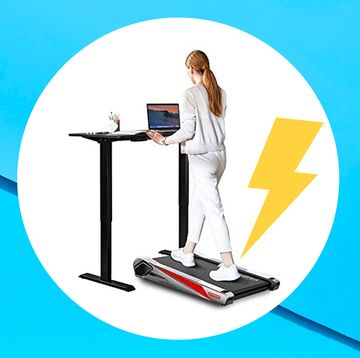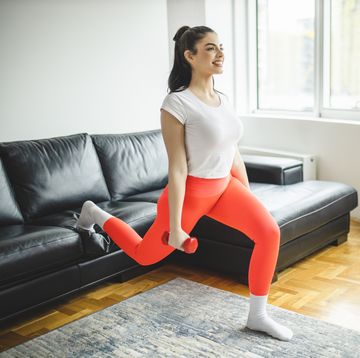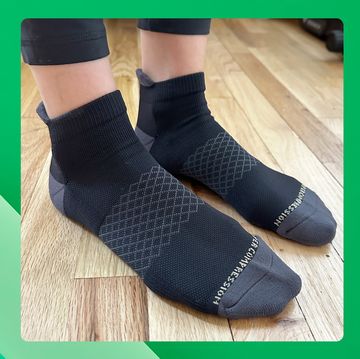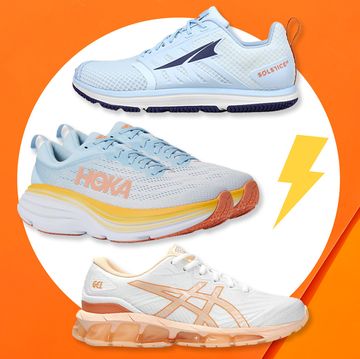What would you do to win gold in London?
For most athletes, they'll go to near extremes to boost their speed, improve their skills, and speed up their recovery time. Cue the Rocky IV montage in which the Italian Stallion chops down trees, dons a horse harness, and runs through waist-deep snow–all to beat a Russian. Just once. That's the kind of extreme we're talking about. Check out the following innovative (to say the least!) ways some of U.S.A.'s best prepped for the 30th Summer Games.
ANTIGRAVITY TREADMILL
The Gist Rather than feeling the impact of every step on the treadmill, this machine allows an athlete to take a load off—literally. Using NASA technology, he or she steps into a pressured-controlled chamber from the waist down. In a process called unweighting, the machine is set at a percentage of the athlete's bodyweight—starting as low as 20 percent (ideal for someone rehabbing an injury)—before walking or jogging as normal.
The Believers To Gavin Noble, a Specialized triathlete competing for Ireland at the 2012 Summer Olympics who used the device in February to rehab a stress fracture in his shin, it's like running on the moon. "Being weightless was a little weird at first, but then it's fun," says Noble. More than that, it sped up his recovery. "I was on it every other day for up to 60 minutes at a time for two weeks." Normally, that injury would sideline you, but by relieving the pounding on joints, ligaments, tendons and muscles, he could continue to train as he healed. Team USA's marathoner Kara Goucher and basketball star Candace Parker, also like to defy gravity. "I started using it two years ago after experiencing a great deal of swelling in my knees," says Parker. "It allows me to do high-level cardio without taking a toll on my body."BUNGEE CORDS & PARACHUTES
The Gist Tie one end of a bungee cord to a pool's starting block, and attach the other end to a belt around a swimmer's waist. The athlete then pushes off and tries to swim against the resistance of the cord. To mix it up, a swimmer can also pull parachutes through the water as you swim laps.
The Believers Coach Dave Salo, head swim coach at the University of Southern California, is famous for thinking outside the pool, which is why Jessica Hardy has called him coach since 2003. "On a really exciting day, instead of tying the bungee cord to a starting block, we will have a partner hold onto the other end while standing on top of a kick board outside the pool," says Hardy, who swam a personal best in the 100m free to land a spot on the 2012 Olympic team. "It's really hard to stay vertical while being pulled horizontally [by the swimmer in the pool], making it a great core workout for both athletes," she adds.BRAIN MAPPING
The Gist Sitting in front of a big TV, athletes are asked to play a video game while wearing high-tech headgear loaded with wires and sensors that monitor brain waves. During the game, the athlete is instructed to focus on keeping their anxiety and stress levels in check, even when a third-party actively sabotages their performance, like dropping a black cloud over the screen when they're doing well.
The Believers "I started brain training in a Neurotopia lab back in November 2011 to pinpoint my weaknesses and work on improving my approach during practice and competitions," says Hardy. "I brain train for 45 minutes up to three times a week and have mastered neuro-agility (the ability to handle multiple stressors at the same time) and impulse control (keeping focused on one point)." Hardy is such a fan that four months ago she recruited her skeptical teammate Eric Shanteau, who qualified for London in the 100-meter breaststroke. The swimmer who famously put off treatment for testicular cancer to compete in the Beijing Games says that the training has helped better manage his emotions, too. "I definitely have a more calm excitement about racing now," he says, "The optimum place to perform is at a 5 on a scale of 1 (asleep) to 10 (crazy). I'm right in the middle, which I think will help me race as fast as I can."TEMPERATURE PILLS
The Gist An athlete pops a Tylenol-looking electronic pill, then waits. (The most accurate readings are made once it's digested by the intestines, which can take up to two hours.) An external computer picks up the wireless device's harmless frequencies from inside the body and measures the athlete's core temperature plus other vital stats. If the read is too high, he or she can put on a cooling vest during their warm up or take a post-workout ice bath. The pill safely passes through their system within 18 to 30 hours.
The Believers "A lot times, it's not the training or competition that's hard, but rather the adaptation to the environment," says Dean Golich, a top endurance coach at Carmichael Training Systems who works with world champions and Olympic medalists. "Athletes often slow down because they're too hot, so when heat is a factor at a major competition, we'll use this thermoregulation pill to help keep them cool and performing their best." According to Golich, the U.S. Women's Olympic field hockey team has used this method.CRYOTHERAPY
The Gist An athlete will step into a super cold chamber (we're talking chilled with liquid nitrogen to minus 166 to minus 220 degrees F), donning gloves, socks, ear warmers and a bathing suit—you know, to avoid frost bite and protect his or her extremities. They'll hold out for three to five minutes. Why, you ask? The beyond-frigid conditions force a spike in blood flow in an attempt to help the body maintain its temperature. That circulation boost can last up to hours after leaving the chamber, which can help combat muscle soreness and fatigue.
The Believers "Initial research has shown faster recover from contusions and bruises," says Golich, who notes that the pro rugby team practices this method. Two-time U.S. Olympic runner Dathan Ritzenhein, who will compete in the 10,000-meter in London, has had the treatment at Nike's campus in Beaverton, Oregon.AIR BOOTS
The Gist Faster recovery in two simple steps. First, athletes slip on a pair of footless, thigh-high nylon stockings over bare legs. That's followed by an open-toe NormaTec MVP compression boot over each leg. Okay, there's three steps: They kick back and relax while the boots rhythmically inflate and pulsate to reduce swelling, muscle fatigue, and stiffness over the course of 15 minutes.
The Believers U.S. Olympic triathlete Gwen Jorgenson and Erin Densham swear by these air boots for recovery. "It's helps drain the lactic acid," says TJ Tollakson, another professional triathlete.ARTIFICIAL SIMULATION
The Gist A new canoe and kayak slalom course, complete with a seven-meter raging waterfall, was built in the Kaituna River in New Zealand—just for training.
The Believers "We'll be racing a huge powerful artificial whitewater course that pumps 16 tons of water per second at the Olympics this year, so I knew I had to take my training to the next level," says New Zealand kayaker Mike Dawson, who plotted the mentally and physically-demanding course with Czech kayaker Vavrinec Hradilek. (Here's a sick video of Dawson and Hradilek tackling the course.)
Cristina Goyanes is a seasoned writer, award-winning editor, and founder of ThisIsRevel.com, a brand editorial agency for companies dedicated to improving people's lives. She is a proud American-Latinx born in Queens, NY, currently living in the Bay Area with her partner and four bikes.













